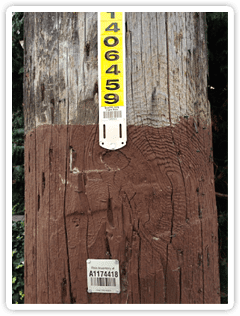 I walked by this utility pole the other day and counted three different identifiers attached to it. I see this quite a bit in our business: a new team or vendor undertakes a tagging effort and imposes a new identification scheme to replace an older scheme like applying a new coat of paint. Why? Because the old scheme has become unreliable to the point of uselessness. How can you design a barcoding scheme that will be the last one that your company has to implement?
I walked by this utility pole the other day and counted three different identifiers attached to it. I see this quite a bit in our business: a new team or vendor undertakes a tagging effort and imposes a new identification scheme to replace an older scheme like applying a new coat of paint. Why? Because the old scheme has become unreliable to the point of uselessness. How can you design a barcoding scheme that will be the last one that your company has to implement?
Don’t print the labels yourself
By printing your own labels, you’re printing the seeds of your own destruction, or at least the destruction of your labeling effort. Self-printed labels won’t even hold up in an office environment; their ink will wear off or fade, their paper will shred and invite picking, and they won’t reliably stick to everything you need them to stick to.
If you’re printing your own labels, who or what is enforcing uniqueness of your labels? Duplicate label values corrupt your numbering system. They prevent field personnel from quickly identifying assets and they mess with the credibility of your asset repository. The possibility of corruption increases when you have multiple people at multiple locations printing labels.
You should be purchasing rolls of pre-printed, high-quality polyester labels with the correct laminate and adhesive for your needs. These label rolls can be distributed to whomever on your organization needs them. Your label vendor should be responsible for maintaining the integrity of your numbering scheme, particularly if they have a check digit or some other embedded integrity check.
Make your label values meaningless
Resist the urge to embed a department code, budget code, or some other meaning into your identifier, e.g., “ACC49001-03” meaning that this asset was purchased by the Accounting department under budget code “03”. Business rules change and asset ownership changes, and you want your numbering scheme to outlive those changes. Never put yourself into a situation where a piece of equipment must change its identifier.
Make your label values distinct
Your labels are going to be competing with serial numbers, part numbers, service tags, UPCs, etc. A simple numeric value like “000129381” isn’t very distinct. It’s likely that a manufacturer’s serial number or part numbers might share a simple scheme like that, and those “foreign” values might be mistakenly collected as your asset identifiers and begin corrupting your numbering system. If you impose a more distinct pattern like “A followed by nine digits”, e.g., “A000012345”, you know you have enough distinctiveness to tell your asset identifier values apart from other scanned values. You can now:
- Validate label values at data entry time, e.g., to prevent serial numbers from being specified as asset identifiers or vice versa.
- Scrub your asset repository by searching for any non-conforming values and correcting them.
- “Teach” your data entry tool that “A followed by nine digits” is always an asset label, which encourages more accurate data entry.
Still farther down this road is using a check digit in your identifier. Your credit card number is a good example of check digits – if you accidentally “fat finger” your credit card number, it can be immediately rejected as an invalid number. If you’re using a vendor to print your labels, they can produce these mathematically generated sequences for you.
Being aware of what to look for (and what to look out for) is half the battle. To help out, I created a succinct but fact-filled Barcode Label Guide. It’s yours to download for free, just by clicking here.
 Author: Tom Watson
Author: Tom Watson
Tom Watson is AMI’s President and CEO. He began his career in high tech in 1996, as a software engineer for his own software company. After a subsequent stint at IT Asset Management firm Micropath as senior architect for that company’s asset tracking system, he founded AMI to develop hardware asset tracking technology solutions for enterprise IT Asset Management customers.


